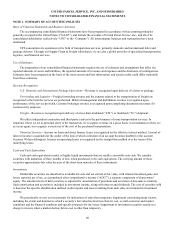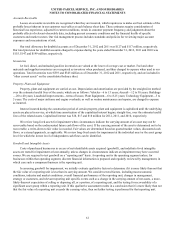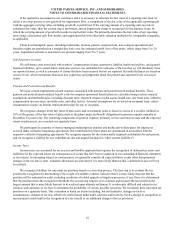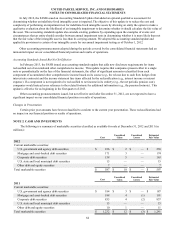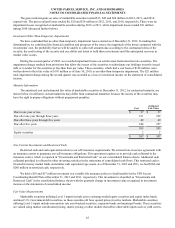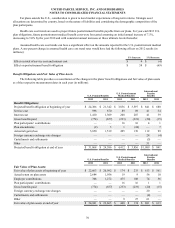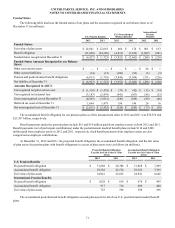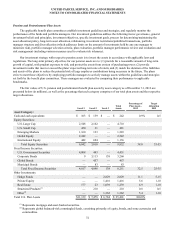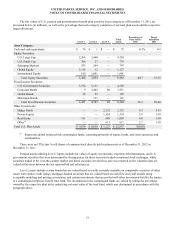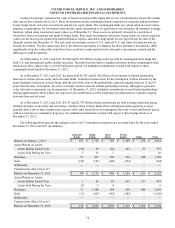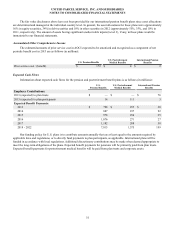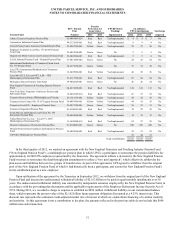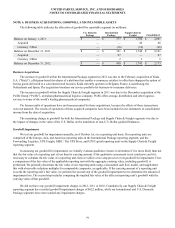UPS 2012 Annual Report Download - page 81
Download and view the complete annual report
Please find page 81 of the 2012 UPS annual report below. You can navigate through the pages in the report by either clicking on the pages listed below, or by using the keyword search tool below to find specific information within the annual report.
UNITED PARCEL SERVICE, INC. AND SUBSIDIARIES
NOTES TO CONSOLIDATED FINANCIAL STATEMENTS
69
Net Periodic Benefit Cost
Information about net periodic benefit cost for the company-sponsored pension and postretirement benefit plans is as
follows (in millions):
U.S. Pension Benefits
U.S. Postretirement
Medical Benefits
International
Pension Benefits
2012 2011 2010 2012 2011 2010 2012 2011 2010
Net Periodic Cost:
Service cost $ 998 $ 870 $ 723 $ 89 $ 89 $ 86 $ 41 $ 34 $ 24
Interest cost 1,410 1,309 1,199 208 207 214 41 39 34
Expected return on assets (1,970) (1,835) (1,381)(18)(16)(22)(47)(43)(36)
Amortization of:
Transition obligation — — — — — — — — —
Prior service cost 173 171 172 5 7 4 2 1 1
Actuarial (gain) loss 4,388 736 70 374 — — 69 91 42
Other — — — — — — (10) — 6
Net periodic benefit cost $4,999 $1,251 $ 783 $ 658 $ 287 $ 282 $ 96 $ 122 $ 71
Actuarial Assumptions
The table below provides the weighted-average actuarial assumptions used to determine the net periodic benefit cost.
U.S. Pension Benefits
U.S. Postretirement
Medical Benefits
International
Pension Benefits
2012 2011 2010 2012 2011 2010 2012 2011 2010
Discount rate 5.64% 5.98% 6.58% 5.47% 5.77% 6.43% 4.63% 5.36% 5.84%
Rate of compensation increase 4.50% 4.50% 4.50% N/A N/A N/A 3.58% 3.57% 3.62%
Expected return on assets 8.75% 8.75% 8.75% 8.75% 8.75% 8.75% 7.20% 7.31% 7.25%
The table below provides the weighted-average actuarial assumptions used to determine the benefit obligations of our
plans.
U.S. Pension Benefits
U.S. Postretirement
Medical Benefits
International
Pension Benefits
2012 2011 2012 2011 2012 2011
Discount rate 4.42% 5.64% 4.21% 5.47% 4.00% 4.63%
Rate of compensation increase 4.16% 4.50% N/A N/A 3.03% 3.58%
A discount rate is used to determine the present value of our future benefit obligations. To determine our discount rate for
our U.S. pension and other postretirement benefit plans, we use a bond matching approach to select specific bonds that would
satisfy our projected benefit payments. We believe the bond matching approach reflects the process we would employ to settle
our pension and postretirement benefit obligations. For our international plans, the discount rate is determined by matching the
expected cash flows of a sample plan of similar duration to a yield curve based on long-term, high quality fixed income debt
instruments available as of the measurement date. For 2012, each basis point increase in the discount rate decreases the
projected benefit obligation by approximately $57 million and $5 million for pension and postretirement medical benefits,
respectively. These assumptions are updated each measurement date, which is typically annually.
An assumption for expected return on plan assets is used to determine a component of net periodic benefit cost for the
fiscal year. This assumption for our U.S. plans was developed using a long-term projection of returns for each asset class, and
taking into consideration our target asset allocation. The expected return for each asset class is a function of passive, long-term
capital market assumptions and excess returns generated from active management. The capital market assumptions used are
provided by independent investment advisors, while excess return assumptions are supported by historical performance, fund
mandates and investment expectations. In addition, we compare the expected return on asset assumption with the average
historical rate of return these plans have been able to generate.



